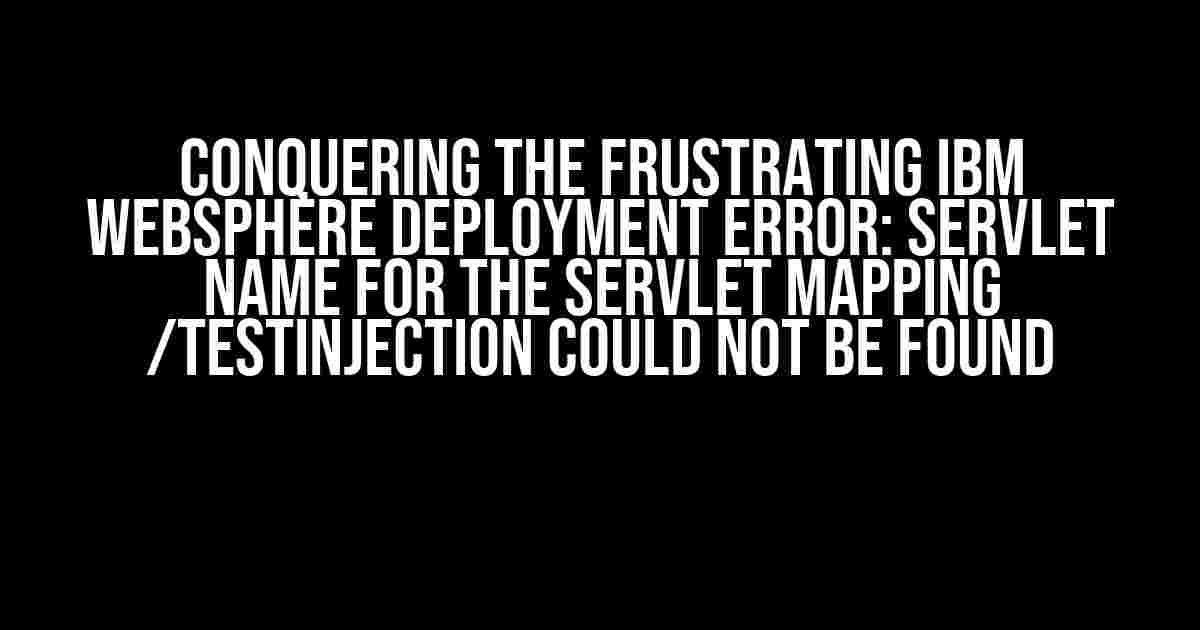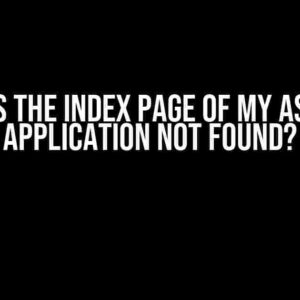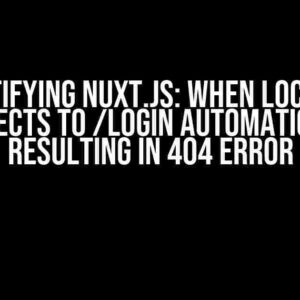Have you ever encountered the infuriating error “Servlet name for the servlet mapping /TestInjection could not be found” while deploying your web application on IBM WebSphere? You’re not alone! This error can be a major roadblock in your development cycle, causing frustration and wasting precious hours of your time. Fear not, dear developer, for we’ve got you covered. In this comprehensive guide, we’ll take you by the hand and walk you through the troubleshooting process, providing clear explanations and step-by-step instructions to help you conquer this pesky error once and for all.
Understanding the Error
Before we dive into the solution, let’s take a moment to understand the root cause of this error. The “Servlet name for the servlet mapping /TestInjection could not be found” error typically occurs when WebSphere is unable to locate the servlet associated with the specified URL pattern (/TestInjection in this case). This can happen due to various reasons, including:
- Incorrect servlet mapping configuration in the web.xml file
- Missing or incorrect servlet declaration in the web.xml file
- Inconsistent servlet naming conventions
- Deployment descriptor issues
Troubleshooting Steps
Now that we’ve identified the possible causes, let’s get started with the troubleshooting process. Follow these steps to resolve the error:
Step 1: Verify Servlet Mapping Configuration
Open your web.xml file and locate the servlet mapping configuration for the /TestInjection URL pattern. Check if the servlet name is correctly specified and matches the servlet declaration. Here’s an example:
<servlet-mapping> <servlet-name>TestInjectionServlet</servlet-name> <url-pattern>/TestInjection</url-pattern> </servlet-mapping>
Ensure the servlet name matches the one declared in the servlet declaration section:
<servlet> <servlet-name>TestInjectionServlet</servlet-name> <servlet-class>com.example.TestInjectionServlet</servlet-class> </servlet>
Step 2: Check Servlet Declaration
Verify that the servlet declaration is correct and the servlet class is correctly specified. Make sure the servlet class is compiled and available in the classpath:
<servlet> <servlet-name>TestInjectionServlet</servlet-name> <servlet-class>com.example.TestInjectionServlet</servlet-class> </servlet>
If you’re using an IDE like Eclipse, ensure that the servlet class is correctly configured and built.
Step 3: Verify Deployment Descriptor
Check the deployment descriptor (ibm-web-ext.xml) for any issues or inconsistencies. Ensure that the servlet declaration and mapping are correctly specified:
<ibm-web-ext xmlns="http://websphere.ibm.com/xml/ns/j2ee">
<websphere-version>8.5</websphere-version>
<servlet>
<servlet-name>TestInjectionServlet</servlet-name>
<servlet-class>com.example.TestInjectionServlet</servlet-class>
</servlet>
<servlet-mapping>
<servlet-name>TestInjectionServlet</servlet-name>
<url-pattern>/TestInjection</url-pattern>
</servlet-mapping>
</ibm-web-ext>
Step 4: Restart WebSphere Server
After making changes to the web.xml or ibm-web-ext.xml files, restart the WebSphere server to ensure the changes take effect:
> stopServer.bat (Windows) or stopServer.sh (Linux) > startServer.bat (Windows) or startServer.sh (Linux)
Step 5: Verify Application Deployment
Once the server is restarted, verify that the application is deployed correctly. Check the WebSphere console for any errors or warnings:
> Deployed application 'TestInjectionApp' successfully
Common Pitfalls to Avoid
To avoid falling into the same trap again, keep the following common pitfalls in mind:
- Incorrect servlet naming conventions: Ensure consistent naming conventions across your web.xml and ibm-web-ext.xml files.
- Overlooking deployment descriptor issues: Verify the deployment descriptor for any inconsistencies or errors.
- Ignoring servlet declaration: Double-check the servlet declaration section for correctness and consistency.
- Failing to restart the server: Remember to restart the WebSphere server after making changes to the configuration files.
Conclusion
The “Servlet name for the servlet mapping /TestInjection could not be found” error can be a frustrating obstacle in your development cycle. However, by following the troubleshooting steps outlined in this guide, you should be able to identify and resolve the issue. Remember to verify servlet mapping configuration, check servlet declaration, verify deployment descriptor, restart the WebSphere server, and avoid common pitfalls. With patience and persistence, you’ll conquer this error and get your application up and running smoothly on IBM WebSphere.
| Troubleshooting Step | Description |
|---|---|
| Step 1 | Verify servlet mapping configuration |
| Step 2 | Check servlet declaration |
| Step 3 | Verify deployment descriptor |
| Step 4 | Restart WebSphere server |
| Step 5 | Verify application deployment |
By following these steps and avoiding common pitfalls, you’ll be well on your way to resolving the “Servlet name for the servlet mapping /TestInjection could not be found” error and getting your application deployed successfully on IBM WebSphere.
- Download the corrected web.xml and ibm-web-ext.xml files
- Verify the servlet declaration and mapping configurations
- Restart the WebSphere server
- Verify application deployment
Remember, troubleshooting is an art that requires patience, persistence, and attention to detail. By following these steps and taking the time to understand the underlying causes of the error, you’ll be able to conquer even the most frustrating deployment issues on IBM WebSphere.
Frequently Asked Question
Get the inside scoop on troubleshooting IBM WebSphere deployment errors and resolve the pesky “Servlet name for the servlet mapping /TestInjection could not be found” issue once and for all!
What is the Servlet name for the servlet mapping /TestInjection error?
This error occurs when the WebSphere application server is unable to find the servlet name associated with the /TestInjection URL pattern. It’s like trying to find a needle in a haystack, but in this case, the needle is the servlet name and the haystack is your application’s configuration!
What are the common causes of this error?
This error can be caused by a variety of factors, including incorrect servlet mapping, missing or misconfigured web.xml files, or even a typo in the servlet name. It’s like trying to solve a puzzle, you need to check all the pieces to find the culprit!
How do I troubleshoot this error?
To troubleshoot this error, start by reviewing your web.xml file to ensure that the servlet mapping is correct. Then, check the server logs for any error messages related to the servlet deployment. Finally, verify that the servlet class is correctly configured and deployed. It’s like following a trail of breadcrumbs to find the solution!
What is the role of the web.xml file in resolving this error?
The web.xml file plays a crucial role in resolving this error, as it defines the servlet mapping and configuration. Make sure to review and update the web.xml file to ensure that the servlet name and URL pattern are correctly configured. It’s like finding the missing piece of a puzzle, and the web.xml file is the key!
Are there any best practices to avoid this error in the future?
Yes! To avoid this error in the future, make sure to follow best practices such as using a consistent naming convention for servlets, thoroughly testing your application before deployment, and regularly reviewing and updating your web.xml file. It’s like having a safety net, these best practices will help you avoid the error and ensure a smooth deployment!





